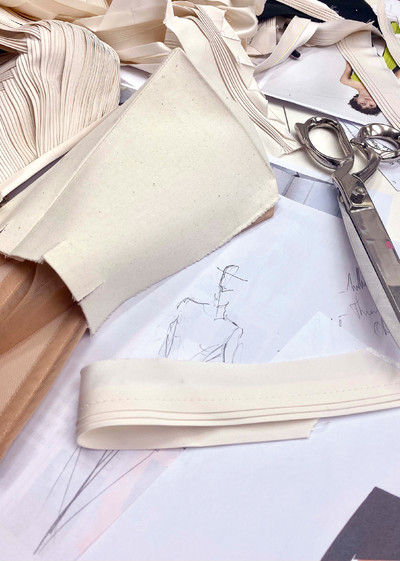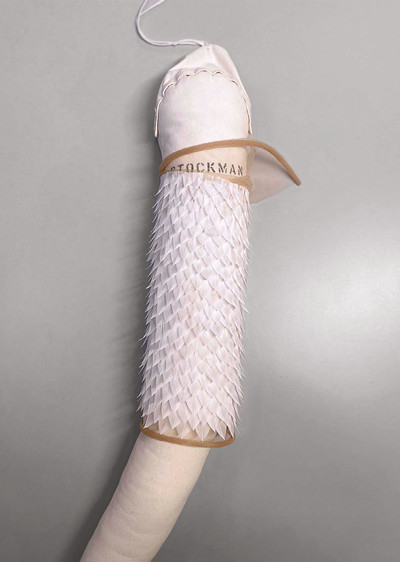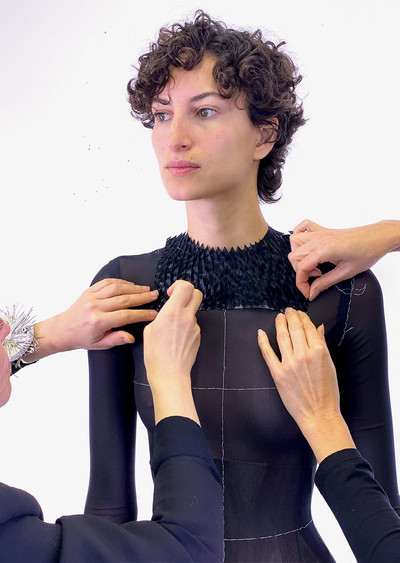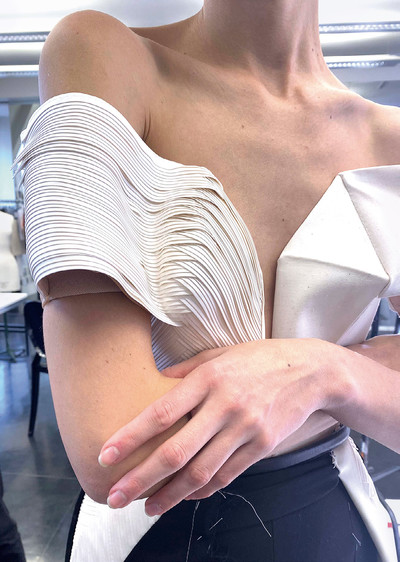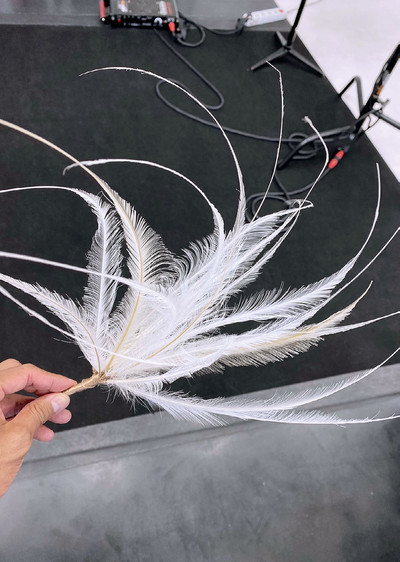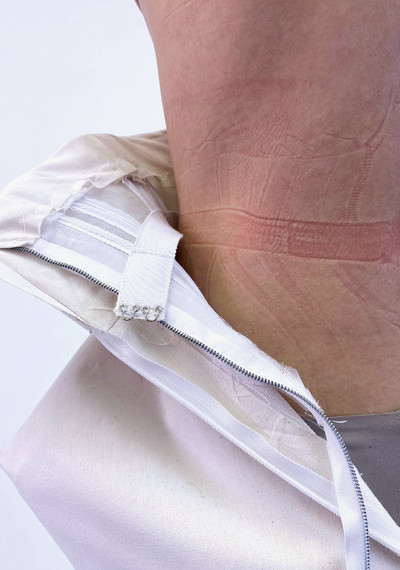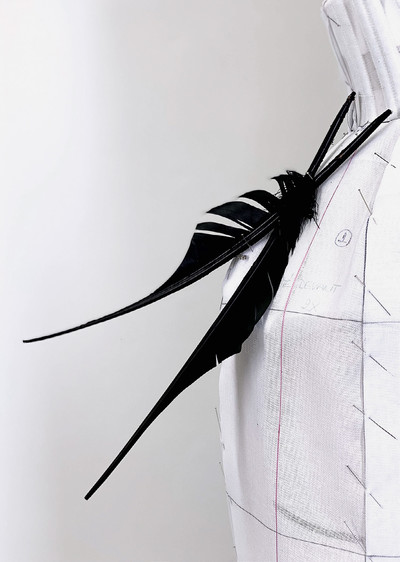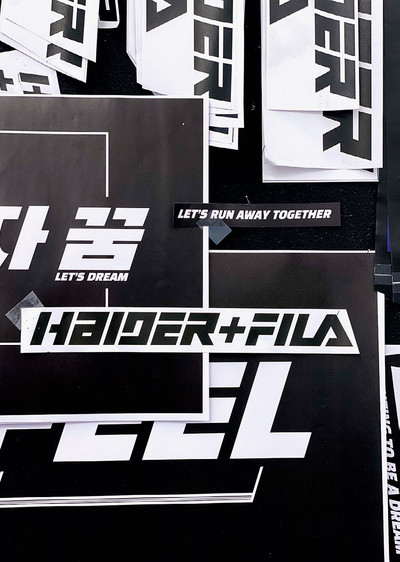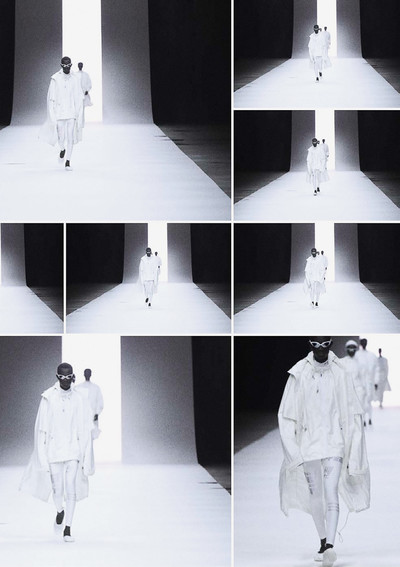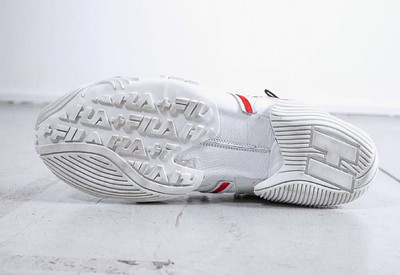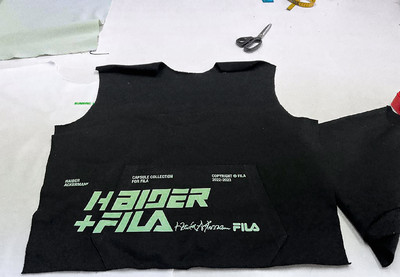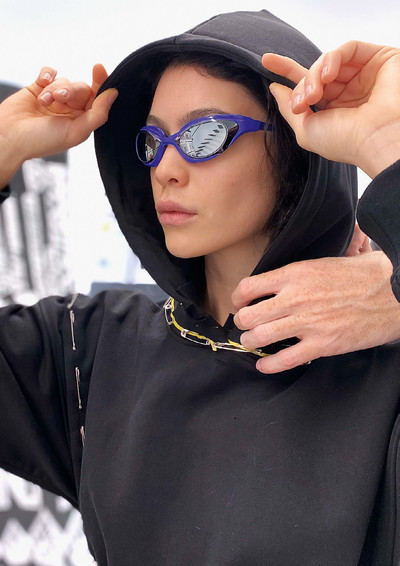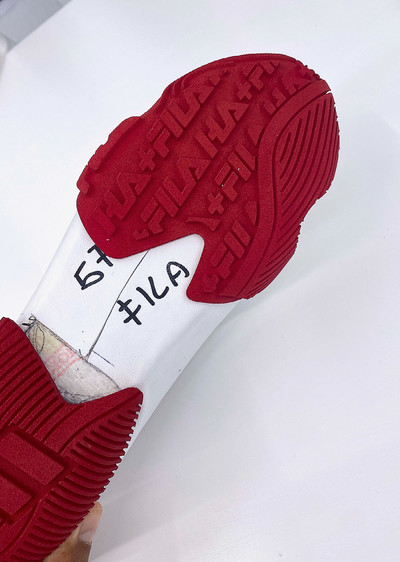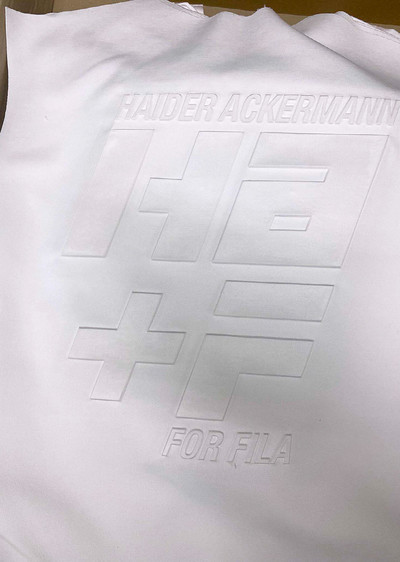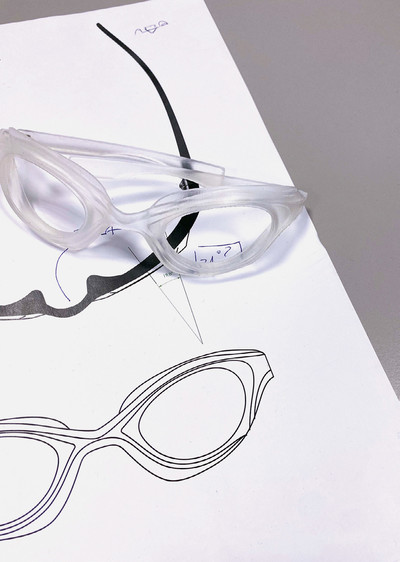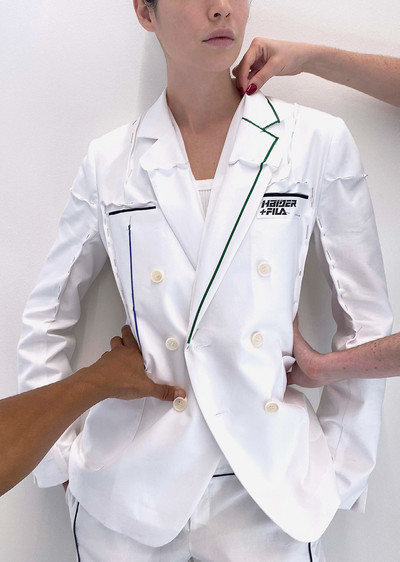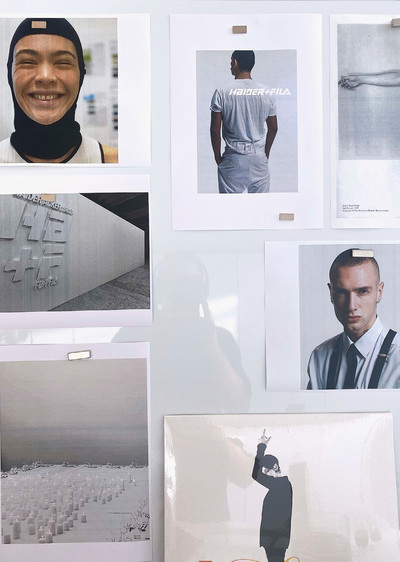Having fought to regain ownership of his name, Haider Ackermann is back, juggling couture and sportswear.
Interview by Jerry Stafford
Portrait by Juergen Teller
Creative partner Dovile Drizyte
Having fought to regain ownership of his name, Haider Ackermann is back, juggling couture and sportswear.
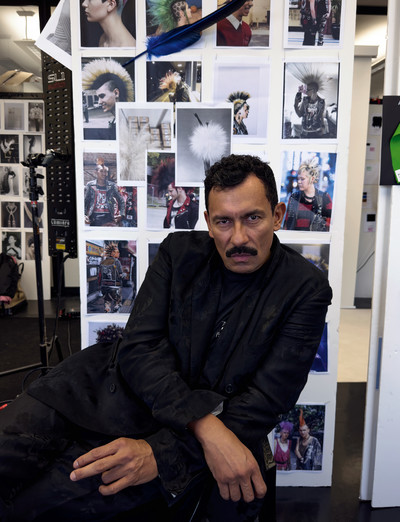
It’s mid-October and Haider Ackermann wants to talk. Fidgeting impishly on a plush circular canapé in the middle of the couture showroom of Jean Paul Gaultier’s HQ in Paris, he is visibly excited and exhilarated to be back at the helm of a legendary fashion house – if only for one season – and relishing the opportunity to elucidate upon his temporary absence from the limelight these past couple of years.
We all experienced the Covid pandemic that began in March 2020 as a collective hiatus in our so-called normal lives, but for Ackermann, the designer who turned 50 last year, it was more the extension of an annus horribilis that had begun in 2019, since when he and his lawyers had been battling to save his name. His former business partner Anne Chapelle had just pulled the plug on their company after almost 20 years of collaboration – she said in a September 2020 newspaper interview that the business had suffered a ‘mega-loss’ – during which the name Haider Ackermann and his unmistakable style synonymous with razor-sharp tailoring, sculpted leather, sensual draping and a jewel-box palette, for both men and women, had earned them Vogue covers and red carpets across the globe.
Chapelle effectively sacked Ackermann during the pandemic and proceeded to claim ownership of his name, potentially banishing him into fashion anonymity. The designer had suddenly found himself the main character in what is now a clichéd fashion story: one of those ‘young innocents’ who sell their soul to the ‘evil financier’ in an unsavoury Faustian pact in which it is their name rather than their soul that is unceremoniously sacrificed.
For once, this cautionary tale of ownership and identity had a happy ending for the designer. Ackermann is, after all, a survivor. A Colombian national, he was adopted by French parents from the Alsace region. His adoptive father was a cartographer and the family travelled widely across Europe and North Africa in his youth and formative years when the designer honed his creative aesthetic and embraced curiosity and conviviality. His collaborative spirit and unfailing discernment and discretion have meant that even in these challenging times his supporters within the industry and his extended family of faithful friends have never been far from his side.
In some respects, the break caused by Covid was in fact a blessing for Ackermann, as his absence from the fashion calendar or what was left of it in those months, went almost unnoticed. Then, as soon as the galas began to roll out again, there he was escorting either Timothée Chalamet or Tilda Swinton down the red carpets of international film festivals, both peacock-proud in their Ackermann plumage!
Now, with the announcements of his stewardship of the next Jean Paul Gaultier couture collection – the latest designer in an ongoing collaborative series that has so far included Sacai, Glenn Martens and most recently, Olivier Rousteing – to be presented in January 2023, and a co-branded collection in collaboration with Fila that launched in November 2022, the designer is back on the map. The skills in gender-fluid tailoring and show-stopping evening wear that he honed for his own signature collections will undoubtably reach new heights of sophistication and expertise in the new role as ‘haut couturier’, while his well-proven talent for high-end sportswear during a frustratingly short-lived stint at luxury brand Berluti should propel Fila firmly back into the fast lane. Ackermann may have lost his voice for a moment, but it is difficult to imagine that he will ever be silenced again.
Jerry Stafford: It must be great to be back in the studio and working once again on a collection. How do you feel?
Haider Ackermann: Great! Today I was really looking forward to talking to you, because I haven’t been talking to anyone about my work for ages, so just the idea of being able to express myself is really joyful; it is a real joy to be working again, a real joy to feel alive and to feel my heart beating fast and to experience the nervousness, the anxieties, and the excitement of these two beautiful projects. Yes, it’s wonderful, really delicious.
Let’s talk about the period of time which led up to these two projects, and look at the last couple of years, which have been challenging for everyone in the fashion industry and beyond. You have been particularly affected over the past two years when your business closed amid rumours of litigation between you and the owner, Anne Chapelle. Can we talk a bit about the beginning and the evolution of this relationship? Why do you feel it ended up in the hands of the lawyers?
I had been working alone for years to build this company of mine. I had started everything on my own and then a hand reached out to me and I was faced with a question of trust. It was the trust you have as a young person wanting to be a designer and wanting to create a collection and be part of a certain world. You put your trust in the hands of someone else, which is in itself a beautiful idea, but at the same time tremendously naive. I always used to say to people, dream your dreams, follow your heart, but time has taught me that you also have to be very anchored in reality and protect yourself, especially as a young designer. You have to immediately surround yourself with lawyers. It sounds harsh what I am saying but you have to protect your future.
Would you nonetheless say that Anne Chapelle was the first person to recognize your talent and support you financially?
No. The first person who recognized my talent was [fashion publicist] Michèle Montagne. She was the first to see something in me and she has been my backbone ever since. She was the one who believed in me from the start and spread the message to the fashion world.
Did you sense from early on in your relationship with Anne Chapelle that you had signed an almost Faustian pact with her? From the very beginning you were aware that she was going to own your name?
She only had my name in licences, which is very different; I never wanted to sign over my name. You have to understand, I am an adopted child, so without becoming overly emotional about it, my name is the only thing I carry from my parents. That is the only thing I have. There is no way in the world I would have given my name to someone else. To have your name on licences is supposed to be a collaboration; it is supposed to mean building up a company together and being on the same page about where one would like to take it. Obviously we had our differences and of course, one cannot escape what happened over the last few years but at the same time there is no reason to… all I can say is that now I can breathe again. I feel free and liberated again, and I am overjoyed at being able to work.
‘You have to understand, I am an adopted child, so without becoming overly emotional about it, my name is the only thing I carry from my parents.’
Was there a positive working relationship with her, when your business was developing and you were very much the focus of the fashion world, or was there always this sense of ambiguity over ownership and trust?
There was always this sense of ambiguity, this fear of ownership and, perhaps the weirdest thing – and I’ve never told this to anyone – is that the day I was supposed to sign, I could not.
Sign with Chapelle ?
Yes. I could not put my signature on the paper. The gesture just didn’t come. We had to postpone the meeting and meet up again another day for me to sign. This should have been a sign of things to come! I knew it wasn’t right. It wasn’t a smooth gesture and perhaps I should have read between the lines. I am sure she might have had the best intentions, but…
Do you think your decision to work with Berluti affected your relationship with her? Did it drive a wedge even further between you?
Of course. No one likes to feel like the other woman and she probably felt this way. I cannot speak for her, but one should be generous and embrace someone else’s future, and she didn’t want to embrace my success or my future… It was very ambiguous, almost as if she wanted me to be there but not be there at the same time.
Do you accept the idea that she is a businesswoman and all her decisions are consequently made outside of any artistic or creative consideration, and in this kind of relationship there has to be an understanding between art and commerce?
If there is an understanding between art and commerce then you need to surround yourself with marketing directors, commercial directors, and, as a designer, you have to work hand in hand with the business. I never had that conversation and that dialogue, even though I was always searching for it and requesting it. I mean, fantasy is one thing, but you also need to engage in reality and at the end of the day, success is about selling. That is the price, that is what keeps you going, that is what helps you move onto the next collection and grow. I would have loved to have this conversation and exchange. That was why Berluti was such a wonderful experience because suddenly I had someone in front of me with whom I could talk, who could help me to learn and to grow. It was a wonderful adventure.
After the experience of these past years, are you more conscious of the importance of ownership and independence, and are they now the driving force behind your modus operandi?
Yes, the more you feel free, the more generous you are. You are no longer putting yourself in the firing line for nothing – you just want to grow and experience, to be alive and take on all those challenges. I am totally embracing my future again.
While all these changes were going on in the company and Anne Chapelle had removed you as a designer, the Covid pandemic was playing out, so your absence from the fashion calendar seemed less remarkable. Obviously this played to your advantage.
Yes it did. I didn’t want to wash my dirty laundry out in public; there is nothing interesting about doing that. The timing played to my advantage, and I have spent most of my time since then surrounded by lawyers fighting to get my name off those licences. Meanwhile, collections have been done with my name on them, but without me, to sell tracksuits and sweatshirts. And yes, it is very tricky to accept that people can use your name to continue those licences without you. It is quite a violent blow! You are screaming out to be part of it, to be able to check it, to view it, but you can’t.
‘It is tricky to accept that people can continue using your name to do tracksuit and sweatshirt licences without you being involved. It’s a violent blow!’
Were you at all concerned about how you would be perceived by the fashion world at that time?
No, the only concern I had was to fight and get my name back. I had worked so hard for all those years, so there was no one in the world who was going to take that away from me. I prefer discretion, it is a protection, and there were all these things going on in the world and so people weren’t interested in me.
Never complain, never explain. Very British! You were also very lucky because as soon as things opened up again, you were able to work independently on high-profile red-carpet events with two of your long-term collaborators, Tilda Swinton and Timothée Chalamet. Was this something that you consciously initiated to maintain your profile?
Yes, and I was also very lucky to be supported by those two people, to share their faithfulness and loyalty at a time when all this was going on in my little life. Even knowing what the rest of the fashion world didn’t, Tilda and Timothée kept knocking on my door and wanting me to be out there with them. I owe them – and, of course, you, Jerry – a lot for allowing me to maintain this presence on the fashion circuit where people could still see me, like a glimpse of my absence. It was very strange being out there and then disappearing again. It was necessary for me also to feel alive, to exist.
Let’s talk about Tilda as you have been working together for a long time now. Why do you think your collaboration works so well and how do you think it might develop in the future?
It has been 20 years and if we actually go back to the beginning of this friendship, you were the person who introduced Ms Swinton to me personally and professionally – you are the basis of this whole friendship. She has been a play companion all those years since and it is so important to feel supported and surrounded in this way. One doesn’t talk enough about friendship in our field, and for me, the word friendship goes hand in hand with the word trust. The fact that you support each other, you stand by each other, you are companions, you are comrades, and as the years go by, you challenge each other, you go further, you experience good things and sad things, but this continuity is enriching and makes you stronger. There is nothing more beautiful than that. I am really touched by such loyal friends; it is my luxury.
‘Haider
Came into my life over 20 years ago as an inspired and inspiring designer
Whose fluidity, sharpness and freshness of line spoke to me immediately of a rare and thrilling atmosphere.
My first dress from him was liquid gold
And it set the tone:
Eternally supersonic
Effortlessly elegant
Innately rock and roll.
A dream of boundarylessness
Beyond time, beyond gender, beyond geography.
Since that first encounter, he has become, beyond one of my most cherished and eternal collaborators, a friend of my closest heart
Truly my brother
One of my sweetest life companions
Whose intimate sensitivity, friendship and loyalty is beyond rubies to me.
To travel the planet with Haider – as I have done now for years on our yearly odysseys – is my favourite of all adventures.
If the shapes we make together are high on my heap of treasures, the NEVERENDING FUN we have together – WHEREVER AND WHENEVER – is among my life’s most precious jewels of all.’
Tilda Swinton
How did you meet Timothée?
It was all accidental. It happened when I was working for Berluti and I got a request from Brian Swardstrom [agent for Chalamet and Swinton], asking if I would be interested in meeting the young Chalamet. It was his first red carpet in Berlin, for Call Me by Your Name; I didn’t know what would happen afterwards – I didn’t see it coming. Sometimes you meet someone, and you just know you can build a story together and have a moment together that may really last.
‘Haider is one of my closest friends and a creative from a lost era – his is the rare passion that cares about the purity of design, shapes, colours, textures, and the feelings they evoke. He couldn’t possibly pretend to care about a fashion cycle or algorithm-influenced trends – his talent and creativity are set to last because he is following his own drum beat, no one else’s.’
Timothée Chalamet
The two most recent collaborations were at this year’s Venice Film Festival, and both were very impactful. Let’s talk first about Timothée; how did the idea for that silhouette evolve? That backless red shantung waistcoat and love handles went viral and was a huge moment for you!
[Laughs] It was just about questioning. We talk a lot about transgender and gender fluidity, which I am of course intrigued by, but not particularly attached to. What I do find interesting, though, is the vanity of men, and how men are vainer than they used to be; they are more challenging. Timothée is in full view at the moment, so we wanted to create a moment and raise questions, to see how far we could go with something, to see what could be done with a man who is very masculine showing his sensibility, showing his nudity. Why is nudity always about women? That questioning came about when we were just playing together. I noticed the assurance he had when he started walking and looking at himself in the mirror, and I was like, OK, we have to do something challenging as you feel so confident and you look at yourself with such self-assurance. There was all this seductive energy going on and I was like we have to do this. It was not prepared and it was not calculated. There were no stylists around; it was just him and me playing around, and that is how it came across. That is the beauty of our businesses: when you’re with a close group of people, you can build and create together. Nowadays, the industry is so big and you have to be surrounded by so many people with so many opinions that you lose perhaps these kind of special moments.
Tilda’s silhouette was equally impactful in Venice this year. Did you approach that silhouette knowing already that you had the position at Gaultier Couture? Did you approach that dress as a couture silhouette, more so than you might have done in the past? Did you want her to project on a different level?
Perhaps, and perhaps unconsciously it also affected my work with Timothée. Lately I’ve been looking at all the archives and Monsieur Gaultier had already begun subverting the codes like 20 or 30 years ago; it is almost ridiculous when you look back on it. It is immense! He played with fashion on every cultural level and let’s face it, he did a naked back on a guy 30 years ago! I only realized last week, looking back at all the archives, that everything has been done before, which is fascinating and beautiful. So perhaps unconsciously all this was playing in my head, which just gave me the freedom to play after having been this prisoner for such a long time, for these two long years!
Did you really feel like a prisoner?
Yes. I couldn’t breathe for so many years, not knowing where my future would go or if I would be able to work again, because it felt to me like she would do everything to keep me small.
To keep you personally feeling unimportant and undervalued or to keep the business small and not expand it?
I think one is related to the other. To keep me small as a person and play with my insecurities. It was a very damaging and perverted relationship. Absolutely! You scream all those years in silence, but there is no sound coming out, and so perhaps I’m feeling free again and I just wanted to embrace my world and the joy of working. I wanted Tilda to shine, and I wanted Timothée to shine, and I really wanted to be out there questioning myself again!
And you did an amazing job! Another project you worked on during this period was with Timothée for Afghanistan Libre, a human-rights association, for which you created a sweatshirt to raise money for and awareness about the rights of Afghan women. How did this come about? Why did you want to do this with him particularly?
I was raised in Ethiopia, Chad and Algeria – countries with big Muslim populations – and the women in these countries have always been such a part of my vision and my creativity, so the idea that men could deny these Afghan women their education and their only way to exist as people revolted me. Women and girls are being reduced to silence and deprived of their liberty, and their courage is incredible as they risk their lives to defend their basic human rights on a daily basis. I had to do something. I had to be out there and raise money and talk about it. I am doing haute couture now, which is all about embracing femininity, the adoration and sublimination of a woman. And suddenly you have all these women in Afghanistan and in Iran, whose lives are in peril. These are issues about which we have to talk.
You have been very open in your support of the protests taking place in Iran at the moment, so does politics have a place in the fashion industry?
Yes, of course, it is about freedom, and freedom is having no fear, as Nina Simone so justly says. My purpose is not to be politically engaged; I want to celebrate the beauty of each person and give them freedom in their movements and gestures. It is shameful to see what is happening. I cannot understand why people are so silent about it in our industry – no one talks about what is happening in Iran. We need to look at what is happening around the world; everything is related.
You have of course been approached by other people to work either as a designer or a creative consultant. Kanye West, aka Ye, has always been a big fan of your work and has approached you in the past to work with him. Did you ever seriously consider doing that?
No, I think the man has his own creativity but… it’s really strange to talk about it now [in late October]. I had the feeling that it wouldn’t be a healthy relationship for me. I had come out of such a damaged one that everything I wanted to do and wanted to embrace needed to be an extension of my own art and my own gesture. I don’t think I would have had this working relationship with Kanye in spite of the fact that I do really respect his music and work…
So this brings us up to the present day and the announcement of your collaboration with the Italian sports company Fila, and your appointment as the next couture designer at Gaultier Haute Couture, following Glenn Martens and Olivier Rousteing. Here we are at the Jean Paul Gaultier headquarters in Paris where you are currently doing fittings. When did you start to design this collection, because I am sure the creative process started a long time before the announcement was actually made?
Yes, we started in July, as soon as Olivier was finished, when I entered this beautiful building and started to go through all the archives to explore the work of Monsieur Jean Paul Gaultier, which as I said before is extraordinary, amazing! I was less aware of how deeply his work embraced cultures and questioned society. Everything that we are talking about now, he addressed 20 years ago. People know all about his fantasy, his folie and his joyfulness, but there is a real couturier behind all of this – a man who in his early couture shows does the best tailoring! To touch haute couture has always been a dream of mine. I have a feeling I am suddenly doing everything I wanted to do. It really is like a beautiful gift.
What is your relationship with Jean Paul himself and how did your initial conversations with him pan out?
Jean Paul, Monsieur Gaultier, chooses you and obviously I feel very honoured to be chosen, but then he steps back. He doesn’t want to hear any more about it; he wants to be surprised. So we met, we went to his place, we had dinner one night, and talked more about his love life and our sex lives than anything else. I wanted to capture every word to inspire me in my work, because it is all about the language, and yet at the same time, we had so much more in common than I ever thought we would have, so it is a very interesting journey.
‘Monsieur Gaultier chooses you to do his couture, but then he steps back. He doesn’t want to hear any more about it; he just wants to be surprised.’
Did you not talk about fashion at all? Or the way that you perceive his work or the way he perceives your work?
Not at all! Perhaps I wanted it to go that way, but I wanted to give him carte blanche to talk about whatever he wanted, and I just listened like a little kid listening to his master. He was living and working in an era when it was all about freedom. When we bumped into each other at a Grace Jones concert in London earlier this year, he told me he started in 1974, I mean…
What is your relationship with Puig, the current owners of Gaultier? Do you work closely with the people there?
I just work with Monsieur Gaultier’s creative team; they are the only people with whom I am in daily contact, and those are the only conversations that I have. When they say it is carte blanche, it really is. I have only had conversations with Antoine Gagey, the general manager at Gaultier…
About where you would like to take things creatively?
Yes, but then again, there is trust…
So there are no real guidelines?
No, no. There is a beauty in having a different designer each season, even if that might be very difficult for the pattern-makers upstairs with a different hand and a different designer every time, but they have to recreate this bond, which is interesting for them. We are totally free to do whatever we would like to honour Monsieur Gaultier.
So are they all the same petites mains who worked with Jean Paul?
Yes.
The same atelier, all of them?
Yes, which is really charming. Haute couture is such a moving experience because you work with people who are so passionate. The plumassiers, the embroiderers, all the petites mains – these are people who spend hours and hours doing their work and can talk for hours about it. There is such passion.
How many people work there?
Approximately 20. The most beautiful gift of haute couture is the opportunity to really take the time to do something.
Is it a completely new way of working for you? All your experience and formation has led to this, so do you feel that it is a natural progression for you? Are you comfortable in this role?
I feel totally comfortable to be honest, and I feel strangely less insecure than I would normally be. I really enjoy it because I am learning every day. Every day is a new day; it is interesting and fascinating. I am growing every day which is the best gift I could receive.
What is your vision for this collection? I mean how are you balancing the visual and creative heritage of Jean Paul Gaultier with your own vision, because Haider Ackermann has to be present in the story…
Tailoring has been a big part of Jean Paul’s work and mine, too, so this is a common playground, and something to continue. I think there are many points where we touch. It is a dance. I am taking a dance here, and that is very, very nice; yes, it is really beautiful.
So why do you think you were chosen to head up this collection? Why do you think Jean Paul approached you?
I didn’t dare ask him! I would love to ask him after the show and hopefully I will succeed and make him proud that he chose me this season. It is good that I do not know as it has given me total freedom, otherwise I might have been more restrained and focused on those reasons.
Have you met any of the couture clients?
No, I haven’t. I have met the director of the haute-couture department and requested to see images of all the best clients in the world, to know their faces, to know where they live, which is interesting.
It is important.
Very, as I would like this couture to sell. I would like it to be worn. I have always been seduced by couture and the idea that a woman can be transported by these fabrics and that she can feel like the most beautiful woman in the world. I would like people to buy this collection – and I would like to see the figures afterwards!
Do you not think that it’s important for you to start meeting the clients themselves before the show?
I don’t think I want to meet them. I just wanted to know where they were coming from, what their jobs are, what they are about, what are their favourite pieces at Jean Paul Gaultier, what are they searching for related to Jean Paul. Because one needs to be quite eccentric and daring to wear Jean Paul Gaultier; it’s not the easiest choice. There are lots of people in the art world, lots of eccentric ladies out there, but…
Jean Paul Gaultier has also done exquisitely classical pieces that are incredibly easy to wear.
Absolutely, in his early couture work, which is where I would like to take my work. I am guided by these very pure perfect pieces and less by the folkloric aspect.
How do you think the last three designers for the house – Sacai, Martens and Rousteing – approached the challenge? Were they successful?
Each one, in their own very different way, composed a love letter to Jean Paul Gaultier. Glenn was more serene and discreet and more Belgian about his approach compared to how Olivier honoured all the iconic pieces.
Have you felt any pressure to impress and to come back with a big bang or are you happy to take it slowly and ease back into the saddle?
I don’t know why, but I have this confidence. I feel that everything is going to be alright. I am here and am so happy to work, so I will not let any of my insecurities distract from this moment, although being insecure does also help push you forward in a certain way. January 25 will be a beautiful evening.
Let’s move from couture to sportswear.
Yes, from one world to another!
You have done a collection for Fila, produced in Milan where you have been commuting these past months and which launches on November 17 in Manchester. So tell me about how this collaboration came about?
It was Fila who contacted me, at first to do a capsule collection, like they had done in the past with Fendi.
When you say Fila contacted you, was there one person specifically?
Valerio [Innella], who is the head of press there, contacted me one night and asked if I would be interested in working with Fila. Of course, it has become a trend for every designer to work with a sports brand so when they first approached me, I made it clear that I wanted to do co-branding rather than just a quick capsule. That means that on every piece we design there is both Fila’s name and my name. For a time my name was not out there, so now I feel like screaming it out everywhere. [Laughs] Even if I always embraced discretion before! So it’s not simply a small capsule, but a real collection and we are working on swimming trunks, hats, scarves and jumpers!
My next question was exactly that, what does the collection include, and have you done a sneaker?
Of course we’ve done a sneaker! We do flip-flops and jogging pants, too!
‘Fila is my youth. When we were young, we all wore Fila. I also remember seeing Fila in the Wes Anderson movie, The Royal Tenenbaums.’
Is it all sportswear pieces?
Fila is my youth. When we were young, we all wore Fila. I remember seeing Fila in the Wes Anderson movie, The Royal Tenenbaums. It was quite high-end back in the day, but now it is more a suburban trend where all the kids are wearing it. I think the reason they chose me was to put them back onto the fashion map and to re-establish their credibility within the fashion industry, so it is a balance between sportswear and casualwear.
So casualwear is also part of the proposal. And what is the price range? Will it be sold as limited editions or is it a big production roll out?
This is one of the first times that Fila’s main house is doing its own collection with a designer like me. So we are selling worldwide; every country is involved. I was interested in collaborating with them because my work has always been very niche and selective, and I wanted it to be out there on the streets. I want the kids to wear sweatshirts I designed!
Why did you decide to present the collaboration in Manchester?
The city has an intriguing mix of contrasting cultures. It’s a place where we hear the voice of youth. There has always been an interesting new wave in sports, music and literature, and I wanted to focus on this unique point of view. It felt right to present the work in the kind of abandoned warehouse space where massive rave parties were held.
Have you discussed sustainability and supply chains with Fila? Are you comfortable with how they work with human-rights and environmental groups?
Yes. They are very concerned with all aspects of this conversation, and more is going to come. I don’t know if I can reveal anything in detail yet, but I know a director [head of global strategic marketing Luca Bertolini] is going to talk at the COP27 summit, just before our show.
‘Couture and sportswear are no longer detached from one another. Look at the couture client in LA: she’s also running in sneakers and jogging pants.’
It is so important! You are at an interesting and transitional point in your career working in two seemingly diametrically opposed domains – sportswear and couture – but which in current fashion terms are powerfully complementary. Everyone aspires to couture, but we all know what sells is sportswear. How do the two respond to each other in your work?
The two things are very connected, just look at the couture client. You will also find her in sneakers and in jogging pants running down the street in LA, so these worlds are not detached from each other! There is a really interesting exchange, one that helps me in my process to make something modern and relevant. It is very now! I would have never thought I would do this, but it is also what designers these days are about.
Yes, both are highly technical, but one is industrial and the other is artisanal…
Yet some aspects and techniques of sportswear will definitely find their way into the haute couture.
Where does this now leave Haider Ackermann and your own brand identity? We’ve talked today about ownership and independence, so now you have your name back and you are the master of your own destiny, where do you see yourself going? Do you want to work for another house, or do you want to hang onto this hard-won independence?
I just want to continue on my path, step by step. All I want to do is work and enjoy everything I am doing, and surround myself with healthy people who have the best intentions to collaborate. Of course you want to express yourself through your own house, but I’m not 25 any more, and I look at things differently now. My approach is very different; I now know what I do and don’t want to do. I am more directive. When I knew I was finally free from any contractual ties, I met with people from the press and from retail to try to understand if I still had a role to play and a voice in the industry.
‘There are all these young kids out there who have a valid voice. So I wanted to understand if I still had something to say creatively and commercially.’
And what was your conclusion?
You really question yourself, because during those two years of silence, fashion was moving forward very fast. Now there are all these young kids out there who have a valid voice. I just wanted to understand if I still had something to say creatively and commercially. Apparently I do.
Social media is a great way of owning or reclaiming one’s voice and it seems to me that it has been very important to you at a time when your identity has been challenged professionally and personally. Has it been a conscious choice?
Yes, because it is a direct voice, speaking directly to your clients and the people who respect you. It is a conversation. Even though I was very scared of social media and I had a complicated relationship with it in the past, I learned – especially at a time when my voice and my name had been taken away – that it was the only honest way to embrace and express both my work and all the people who make it happen. Because of course there is me, but there is also my assistant, friends, a whole gang around me, who are a part of why I am still here today. If I am standing straight today it is because of the backbone of the friends who didn’t give up on me!
Lastly, as a Colombian-born gay man adopted by French parents who has had to fight once again for the ownership of his name, how do you see yourself at this time?
Well, it is an endless fight but, you know, beauty has grown out of all this negativity and all these fights. There has been a strength in these friendships and in the support from the industry. It was wonderful when the collaborations with Fila and Jean Paul Gaultier were announced, how other designers reacted. All the messages, all the generosity I received from the industry, it makes your heart melt, because you feel you really have a right to exist.
